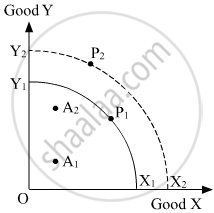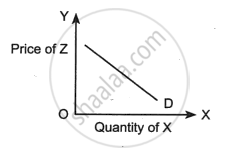Advertisements
Advertisements
Question
Distinguish between normal goods and inferior goods, with examples
Solution
| Basis | Normal Goods | Inferior Goods |
| Definition | Normal goods are those goods whose demand increases with the increase in income and whose demand decreases with a fall in income | Inferior goods are those goods whose demand increases with a fall in income and whose demand falls decreases with a rise in income. |
| Income Effect | In case of normal goods, there is a positive income effect | In case of inferior goods, there is a negative income effect |
| Examples | Branded Clothes, Wheat, Milk | Coarse Cereals, Public Transportation - Bus, rail pass |
APPEARS IN
RELATED QUESTIONS
Explain, with reasons, whether you Agree or Disagree with the following statement
There are no exceptions to the Law of Demand.
Demand curve and Supply curve.
What is meant by inelastic demand?
The demand of a commodity, when measured through the expenditure approach, is inelastic. A fall in its price will result in : (choose the correct alternative)
(a) No change in expenditure on it.
(b) Increase in expenditure on it.
(c) Decrease in expenditure on it.
(d) Anyone of the above.
Distinguish between ‘increase in demand’ and increase in quantity demanded of a good.
When the income of the consumer falls the impact on a price-demand curve of an inferior good is: (choose the correct alternative)
a. Shifts to the right.
b. Shifts of the left.
c. There is upward movement along the curve.
d. There is downward movement along the curve
If due to fall in the price of good X, demand for good Y rises, the two goods are : (Choose the correct alternative)
a. Substitutes
b. Complements
c. Not related
d. Competitive
Define or explain the following concept :
Effective demand .
State whether the following statement is True or False :
Demand for necessary goods is inelastic.
Fill in the blank with appropriate alternatives given in the bracket:
The law of demand states ________ relation between demand and price.
Fill in the blank with appropriate alternatives given below:
Market demand is an aggregate of purchasing by _________ buyers.
Match the following:
|
Group A
|
Group B
|
|
1. Demand and price
|
a. Substitute goods
|
|
2. Tea and coffee
|
b. Inverse relation
|
|
3. Inferior goods
|
c. Joint demand
|
|
4. Factors of production
|
d. Distribution of income
|
|
5. Pen and ink
|
e. Composite demand
|
|
|
f. Giffen goods
|
|
|
g. Indirect demand
|
State whether the following statement is TRUE and FALSE
When demand increases, the demand curve shifts to the left.
Define or explain the following concept:
Derived demand
Answer the following question
What do you mean by demand?
Answer the following question.
Discuss the relationship between the income of the consumer and demand for a commodity with respect to normal goods, inferior goods, and necessities.
Choose the correct answer from given options
In the given figure X1Y1 and X2Y2 are Production Possibility Curves in two different periods T1 and T2 respectively for Good X and Good Y. A1 and A2 represent actual outputs and P1 and P2 represent potential outputs respectively in the two times periods.

The change in actual output of Goods X and Y over the two periods would be represented by a movement from __________.
Which of the following can cause an increase in demand:
"Market demand curve is constructed by horizontally summing all the individual's demand curves at each and every price." Choose the correct option for the above-mentioned statement.
The figure given below shows the relation between the quantity demanded for the good X and the price of the good Z. What type of goods are X and Z?

